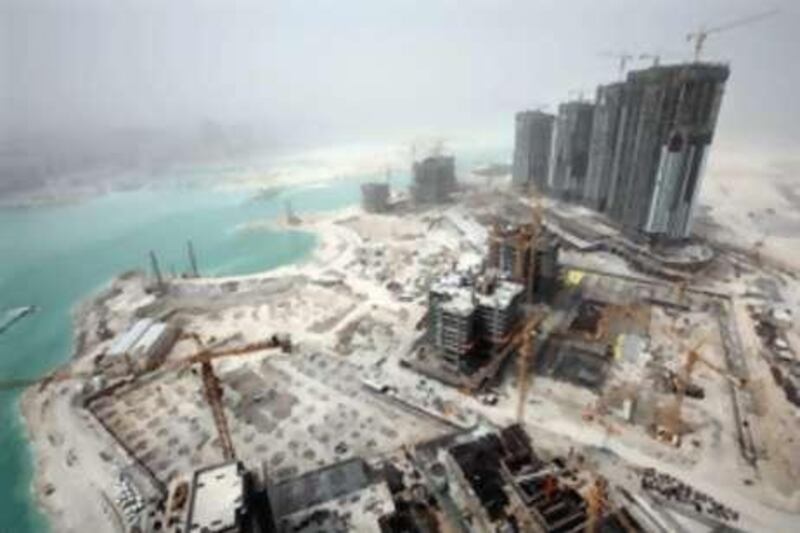The view of Reem Island as you drive down Al Salaam Street in Abu Dhabi shows just a few stray towers jutting into the sky. The scene is strangely quiet. But at sand level, the site is blazing along with thousands of construction workers from three major developers and dozens of contractors raising the whole island skyward. Lorries grumble under the weight of concrete mix and workers call to each other in everything from Urdu to Japanese.
"Hardly a plot on the island is idle," said Tariq Sultan, the chief executive of Bunya, a joint venture between the island's developers to build and maintain the infrastructure. "It may look quiet from Abu Dhabi, but everything is in the works. And that is why we have to work even faster." Already, Bunya's team has installed the basic facilities to handle the first phase of development. This includes several kilometres of roads, power supply and sewage treatment.
But the task ahead of them is epic in its complexity. Mr Sultan and his team of 80 staff, and their subcontractors, are charged with creating the infrastructure for buildings that will house a population roughly the size as Reno, Nevada. Those 200,000 people will live in developments packed on to a mere 870-hectare piece of land. Their budget is about Dh11 billion (US$3bn). But the hardest part? "Co-ordination," Mr Sultan said. "There are three master developers. Each one has its own needs and interests."
The three developers are Tamouh Investments, Sorouh Real Estate and Reem Developers. Both Tamouh and Reem Developers are connected back to Sheikh Tahnoon bin Zayed. Sheikh Tahnoon is said to visit the construction site more than once a week. He also owns an elaborate Spanish-style villa that sits on a small stretch of land on the east side of the island. "He's a very hands-on guy," Mr Sultan said.
Tamouh will be the first company to have habitable buildings on the site, according to the plans. Its Marina Square residential project, which is the one you can see as you drive on Salaam Street, will be finished at the beginning of 2010, according to Joe Ong, the chief executive. The 17 towers will have about 2,880 units. Residents will have access to sport centres, mosques, parks and swimming pools. The project will also include a shopping arcade, cinema, marina, five-star hotel and beach.
The tallest tower had reached 47 storeys, said Samia Bouazza, the director of sales and marketing at Tamouh. Tamouh is also building the City of Lights, a 40-hectare development with offices, retail space and residences, as well as "Fantasy Island", a dolphin-shaped development on the edge of Reem Island with hotels, chalets and a commercial centre with shopping, restaurants and nightclubs. On the back side of the island, Mr Sultan pointed to two high-rise towers by Sorouh as the next to be finished after Marina Square. The project, called Sky Tower, will be part of Sorouh's larger "live, work, play" master development with offices, residences and retail. The plan also includes The Gate District, a set of four buildings attached at the top, and Shams Abu Dhabi, a larger group of buildings surrounding its own 8.1-hectare "Central Park".
Reem Developers is still finalising its plans, but it previously announced Najmat, which means "star". It will be another major community development, surrounding a marina. "This island will be a city within a city," Mr Sultan said. "But it will also have many cities within the city." The key issue for Bunya is to figure out how to support all these diverse communities without much space to operate from. One challenge has been how to lay the wiring and pipes for the water, telecom, electrical and sewerage systems with a short deadline.
Rather than dig into the earth, which is more time-consuming and difficult, they have opted to simply build up. All of the roads have been raised with about six million cubic metres of fill, so that the necessary piping can be installed with ease. The next phases will be increasingly devoted to transportation. Reem Island has been designed to allow for easy travel to both the Abu Dhabi main island and Suwwah Island, where the core financial district is being built by a partnership between Mubadala Development and John Buck from Chicago. Six bridges will connect to Suwwah alone. A major tunnel is being considered to connect Reem to Saadiyat in what would be one of the more ambitious projects in Abu Dhabi's recent history.
The Urban Planning Council and Department of Transport have plans for Reem to contain a light rail, metro, fast-train system and a series of trams. "Connection to the main island is key," Mr Sultan said. "It is important that people move freely between the islands. Reem has to be part of the city." After the giant construction task is finished, Bunya will not disappear. It will continue on as the de facto regulator and maintainer of the infrastructure.
"We will be like a small municipality," Mr Sultan said. "We will make the policies and procedures and ensure compliance." Pausing to let a jackhammer finish its pounding, Mr Sultan wiped his brow and said: "Reem will be different than anything you see now in Abu Dhabi." @Email:bhope@thenational.ae






